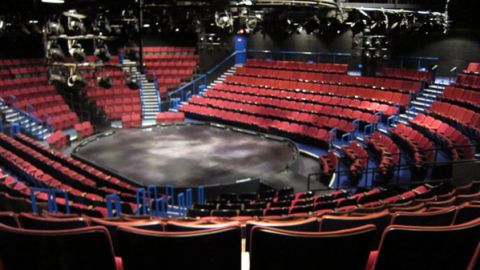After audience members hear “please turn off your cell phones, the show is about to begin,” one expects the lights to dim, the overture to commence, and then the show begins. At the Circle in the Square Theater in New York, Daniel Fish’s Tony Award winning new reimagined version of Oklahoma! could not be any different. The musical, which made its Broadway premiere over 75 years ago, is seen as quientestial musical theatre. This production really places the classic in 2019.
The Circle in the Square, while being the smallest theater on Broadway, is also the only Broadway theater in the round. With only 11 rows of seats, audience members are placed close to the action. The front row is lined with plywood tables, complete with piping hot pots of chili, the back walls are filled with rifles on display, and the ceiling is lined with streamers and string lights. As the show begins, the house lights are on, the actors sternly walk on stage and sit in folding chairs lining the lip of the stage. A curly headed crooner with a guitar begins singing those famous words: “There’s a bright golden haze on the meadow” and the show begins.
The musical is about a small town in the Oklahoma territory at the turn of the twentieth century. The show is typically seen as a typical love story- a boy and a girl flirt for two hours before they kiss and everything ends well. Not this time. The “family friendly” show has new sexual undertones. The first time the two main characters (Curly and Laurey) interact, the lights go dim and they are lit with a green hue. The two actors approach each other and are practically singing into each others’ mouths.
A secondary main character, Jud, is also in love with Laurey. Typically, Jud is seen as a creepy farm hand who lusts after Laurey. In the 1955 film version of Oklahoma!, Jud is burly and loud; he is physically intimidating. This production, Jud is leaner, with red hair coming to his chin and a calming voice. He sits on the side of the stage in a blue hoodie, almost unnoticed. It is not until he is mentioned by name by the matriarch of the show, Aunt Eller, that audience members really see him. He is staring at Laurey and he refuses to stop. In the first scene that really focuses on Jud, the theater goes black, and it is not until Curly starts singing that a single white light shines on the two.
One of the biggest changes to the production is the iconic “Out of Your Dreams” ballet. After the company tells Laurey to “make up her mind” in song, Laurey sings an acapella reprise of the song and intermission comes. The first act climaxes with a decision: does Laurey choose Curly or Jud? It is not until the beginning of the second act that the dream ballet begins (it typically closes the first act). Rather than a typical ballet, audience members watch as a bald girl throws herself around the stage to the sounds of an electric guitar. She is only wearing a tee shirt covered in sparkles with the phrase “Dream Baby Dream” plastered in block letters. Her gasps for air between movements are clear as day, her face intense as she literally crawls and leaps around the slabs of plywood that comprise the stage. It is ten minutes of pure performance art, beautiful and flowing yet raw and bone chilling.
At this time, Oklahoma! has ended its run on Broadway, but the impact of the reimagination is hard to erase. Women of color are seeing themselves in the romantic lead; disabled women feel empowered as the character of Ado Annie is portrayed by a wheelchair bound Ali Stroker (who received a Tony Award for her performance). This reimagination has broken barriers, and it is exciting to see how this will affect other classic musicals planning on making Broadway revivals. Playbill has reported that a touring production of this reimagination will embark in Fall 2020, appropriately beginning its run in Oklahoma City. For more information on the production, visit https://oklahomabroadway.com/.
Source: Playbill

